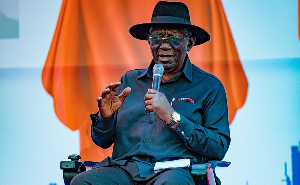Out of Africa – A short History of Ghana’s contribution to football in Britain
Ghana’s draw against England at Wembley Stadium on the 29th March 2011 was proof that Ghana was a force to be reckoned with at international level. Of the starting line-up for Ghana, 5 players of the squad had played in English Premier League. Kingson, Mensah, Panstil, Muntari, and Gyan.
The significance of the draw was hard to quantify as both teams were without key players, and after all it was a friendly, but perhaps what was more significant on that day was the official recognition of the legacy of the world's very first black African professional footballer, Arthur Wharton.
Arthur Wharton was born in James Town Accra, Ghana to the Reverend Henry Wharton, a Wesleyan missionary from Grenada, in the West Indies, and Annie Florence Grant a daughter of a Scottish trader John C. Grant and a Fante royal from the Gold Coast now Ghana, Ama Egyiriba.
Wharton came to Britain from the Gold Coast for elementary schooling in 1875, attending Dr Cheyne’s Burlington Road School, London. He returned to the Gold Coast in 1878, coming back to Britain four years later in 1882. As an athlete, Wharton was a renowned sprinter. In 1886 he became the 3 A’S amateur national sprint champion being the first man to run the 100 yards in 10 sec, setting a new world record. Wharton was also a renowned goal keeper and is now remembered for his brilliant feats in goal keeping.
Wharton played professionally until at least 1902, also earning a living as a publican in Sheffield and Rotherham. He spent the last twenty or so years of his life working as colliery haulage hand, mostly at the Yorkshire Main pit in Edlington, South Yorkshire. He died in December 1930 and was buried in a third class grave in Edlington cemetery which remained unmarked for sixty seven years.
https://www.youtube.com/watch?v=xIl51pdVUVQ
Between 1949 and 1956, there were 3 tours by African National teams to Britain. The first visit was by the Nigerian national team in September 1949. The Nigerian tour was followed in 1951 by Gold Coast XI who toured England and Ireland, and a Uganda XI in 1956
The tours were promoted as learning experiences to the Tourists, but had a wider political significance to the British Empire, who at the time maintained control of many of the African countries, and wanted to retain their influence on the Colonies once independence was granted.
All three team favoured bare bandaged feet for playing, and apart from being too expensive, found it very difficult to play in football boots as it made them clumsy and removed their control of the ball. The most successful outcome of the Tours was the acceptance, and even the support that the Tourists gained from the British citizens; the Evening Mail in Dublin reported that one of the Gold Coast’s games had such a ‘fine display of sportsmanship’, that the affection of the crowd resulted in many shouting support for the players.
Out of the 25 goals scored by the touring Gold Coast team, 11 of the goals were scored by Charles Kumi Gyamfi. CK Gyamfi was to manage the Black Stars later. Tommy Wilberforce who had suffered a misfortune of a broken leg in a 5-2 defeat against Ireland Amateurs during the Gold Coast tour returned to Belfast to study years later with wife Julia Blankson whom he had met during the tour. He later played for Cliftonville between 1958 and 1960.
https://www.youtube.com/watch?v=RG46OYqmXCM
On the 6th of March 1957, the Gold Coast achieved independence from British rule, as part of the celebrations, President Nkrumah used what he knew united people, football. Nkrumah invited Stanley Mathews to play in an exhibition match in the Ghana National Stadium attended by the president himself.
Up to 1962, Africa provided the largest proportion of foreign-born Black players, though still comparatively few in number. However the passage to Britain of Black African footballers slowed appreciably with the introduction and gradual enforcement of the 1962, 1968 and 1971 immigration acts, which had as their aim, the restriction of people of colour entering the country. British football in the 1960s and 70s was notable for its absence of African footballers. A lucky few had arrived before the new immigration restrictions and one or two managed to duck under the colour bar, such as John Mensah at Cambridge City.
It was not until 1978 that the FA relaxed the rules governing the signing of foreign-born players of non-Commonwealth status.
In 1969, Kumasi Asante Kotoko toured Britain to play 6 matches against top sides such Oxford, Birmingham City, and Stoke City. Kotoko had previously beaten Stoke City by 3-1 at the Kumasi Sports Stadium. Osei Kofi scored two goals against one of the then best goalkeepers in the world Gordon Banks. In the return leg at Stoke City’s ground, Stoke avenged defeat, beating Kotoko 3-2, but Osei Kofi, the Dribbling Magician as he was affectionately known scored two goals again, and once again it was Gordon Banks. Following the match Gordon Bank compared Osei Kofi to George Best. Although Stoke offered a contract to Osei Kofi, he was not to return to the UK, a decision he says he never regretted.
By the start of the eighties, hooliganism was rife, and English clubs were banned from European competition for five years following the Heysel Stadium disaster in1985. The Taylor report in the aftermath of the Hillsborough had established the need for football stadia to be upgraded to an all-seater model in England and Scotland. Ghana in the meant time had won their fourth African Cup of Nations title and had firmly established themselves as an African Football powerhouse.
In 1990 English teams were once again allowed to compete in European competitions. But despite the radical changes taking place in British football, it was still not the preferred destination for the emerging talent from Africa. Other European destinations such as France, Germany, and Italy were winning the race to sign African players. Abedi Pele, and Tony Yeboah were both playing in France and Germany respectively. The Black Starlets had won the FIFA under 17 world cup in 1991, and Player of the tournament Nii Lamptey had caught the eyes of the world leading clubs, Lamptey was hailed as the new Pele. In an attempt to keep the team together, the then Head of State of Ghana Jerry Rawlings had asked that none of the players from the group be allowed to leave the country, however with the help of current Nigeria National Team Manager Stephen Keshi, Lamptey left Ghana to become the youngest player to play in the Belgian League signing for Anderlecht. Lamptey was later to play in the English League for Aston Villa and Coventry. Unfortunately he never fulfilled his full potential.
https://www.youtube.com/watch?v=tGoIgwLGRgg
On the 20th of February 1992 following a decision of clubs in the Football League First Division to break away from The Football League, the FA Premier League was formed. With a lucrative television rights deal, the league quickly grew in stature and popularity.
By the mid to late nineties however there was the beginning of an influx of African players. High profile African players who had chosen other European Leagues over English League were now coming to ply their trade in England. Ghana born Kim Grant who was then playing for Charlton Athletic, was joined by Nii Lamptey, and Anthony Yeboah. Kim Grant who is a direct relative to Arthur Wharton was later to play for the Black Stars.
https://www.youtube.com/watch?v=4cG3tAxkhrw
Tony Yeboah is the only player to win the BBC Match of the Day, Goal of the Month award in two successive months – September and October 1995. He also won the 1995 Goal of the Season Award with a goal against Wimbledon. Yeboah Still remains a cult figure at Leeds. He made 66 appearances for Leeds, scoring a total of 32 goals.
By the turn of the century African players were household names across Britain. Africa had become a dominant force in British Football, and a gold mine for new talent. The number of African players playing professionally in Britain had significantly increased, and these master craftsmen were leading their teams to victories.
Michael Essien’s 2005 move from Lyon to Chelsea at £24m was an African record. Essien was followed by players such as Painstill, Muntari, Mensah, Gyan with some players who were not born in Ghana such as Kevin Prince Boateng, and Albert Adomah opting to play for the motherland.
Written by Manny Abbeyquaye
www.outofafricacampaign.co.uk
Sports Features of Saturday, 26 January 2013
Source: Abbeyquaye, Manny












